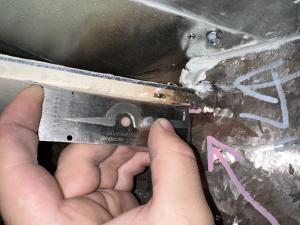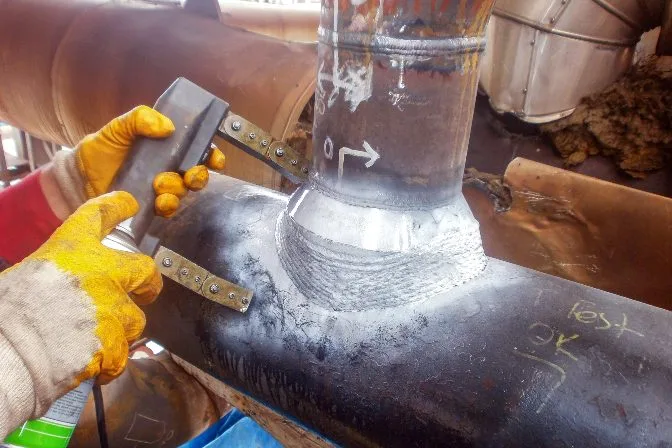What to Get out of a Comprehensive Welding Inspection Racine
What to Get out of a Comprehensive Welding Inspection Racine
Blog Article
Ingenious Approaches to Fillet Weld Evaluation and Testing: Enhancing Weld High Quality and Compliance Criteria
In the world of welding, the high quality and integrity of fillet welds play a vital role in ensuring the architectural stability and integrity of different industrial elements. With the constant drive for enhanced efficiency and conformity with strict standards, the exploration of cutting-edge techniques to fillet weld inspection and screening has ended up being vital.
Advanced Non-Destructive Screening Techniques
Utilizing advanced technologies, progressed non-destructive testing techniques play a crucial function in ensuring the honesty and quality of fillet welds. These approaches, such as phased array ultrasonic screening (PAUT) and magnetic fragment screening (MPT), offer detailed understandings right into the weld's internal framework without triggering any damages to the product. PAUT, for circumstances, utilizes several ultrasonic components to examine the weld from various angles, giving an extensive visualization of potential defects like lack of blend or splits.
By utilizing these advanced non-destructive testing strategies, weld assessors can precisely evaluate the quality of fillet welds, ensuring conformity with sector requirements and policies. The ability to detect imperfections early on not just enhances weld quality yet additionally avoids expensive rework or failures in architectural stability, underlining the value of these ingenious testing strategies in welding assessments.
Robotics and Automation in Examination
The combination of robotics and automation has changed the evaluation procedure for fillet welds, improving efficiency and precision in quality analysis. Robotics offer specific control and repeatability in checking welds, ensuring reliable and constant results. Automated systems can be configured to adhere to particular evaluation paths, making sure comprehensive insurance coverage of welds and decreasing the threat of human error.
Robotic examination systems geared up with innovative sensors can spot and gauge weld features with high precision, giving detailed data for evaluation. These systems can recognize defects such as fractures, absence of blend, and porosity, allowing punctual rehabilitative actions to be taken. Furthermore, robotics and automation enable real-time information collection and analysis, offering instant responses to drivers and facilitating quick decision-making processes.
In addition, making use of robotics and automation in fillet weld inspection enhances general performance by lowering inspection times and raising inspection throughput. By improving the assessment procedure, suppliers can make certain weld top quality and conformity criteria are met efficiently, ultimately resulting in set you back financial savings and enhanced product quality.
Utilizing Artificial Knowledge for Analysis
Artificial knowledge plays a critical role in improving the efficiency and precision of analysis in fillet weld examination processes. AI formulas can swiftly refine large quantities of data from weld examinations, finding defects or incongruities that may be testing to determine with the naked eye - Welding Inspection Racine.
Additionally, AI systems can pick up from past examination data, constantly boosting their ability to identify prospective defects and discrepancies in fillet welds. This flexible understanding capability enhances the general top quality control read this post here procedure, reducing the possibility of human error and ensuring that welds satisfy the needed criteria. By incorporating artificial intelligence into fillet weld analysis, markets can accomplish greater degrees of performance, uniformity, and conformity in their examination techniques.
Portable Devices for On-Site Inspection
 Enhancing field inspection effectiveness, the adoption of mobile devices changes on-site assessment processes for fillet welds. These tools provide versatility and benefit, enabling examiners to carry out detailed exams in various places, including remote or difficult atmospheres. Portable tools such as ultrasonic testing devices, magnetic fragment inspection equipment, and electronic radiography systems give real-time data and high-resolution imaging capabilities, enabling quick decision-making and prompt responses on weld top quality.
Enhancing field inspection effectiveness, the adoption of mobile devices changes on-site assessment processes for fillet welds. These tools provide versatility and benefit, enabling examiners to carry out detailed exams in various places, including remote or difficult atmospheres. Portable tools such as ultrasonic testing devices, magnetic fragment inspection equipment, and electronic radiography systems give real-time data and high-resolution imaging capabilities, enabling quick decision-making and prompt responses on weld top quality.One considerable advantage of portable tools is their capacity to simplify examination treatments, lowering downtime and boosting general efficiency. Inspectors can easily transport these devices to various task sites, removing the requirement for carrying heavy equipment or components to off-site facilities. Furthermore, the transportability of these devices advertises cost-effectiveness by reducing transportation costs and he said speeding up evaluation timelines.
Moreover, making use of mobile devices for on-site assessment promotes aggressive quality assurance measures, as assessors can quickly recognize and attend to any possible welding defects or disparities. By incorporating these cutting-edge technologies right into on-site evaluation techniques, welding professionals can make certain compliance with sector standards and improve weld quality, ultimately causing improved architectural integrity and security in various welding applications.
Combination of Information Management Solution
Having actually optimized on-site assessment procedures via the application of portable tools, the following stage involves the seamless combination of information management systems to even more improve performance and information analysis abilities in fillet weld examination and testing. Welding Inspection Racine. By integrating data administration systems right into the inspection process, organizations can improve information collection, storage space, and evaluation. This combination permits for real-time surveillance of weld quality, immediate identification of problems, and timely decision-making to fix any kind of issues that might arise during the evaluation procedure
Data administration systems play an essential function in streamlining assessment information, promoting very easy accessibility for accredited employees, and making sure information honesty and security. Through the integration of these systems, assessors can create thorough records, track historical data for trend evaluation, and boost general process performance. The assimilation of data management systems makes it possible for smooth communication in between different stakeholders involved in the examination procedure, fostering partnership and enhancing total high quality control measures. Inevitably, the combination of information administration systems serves to raise the standards of fillet weld examination and testing, ensuring conformity with market regulations and boosting weld quality.
Final Thought
To conclude, innovative techniques to fillet weld evaluation and screening have actually substantially boosted weld quality and compliance criteria. Advanced non-destructive testing techniques, robotics, automation, fabricated knowledge, portable tools, and information monitoring systems have actually transformed the method weld assessments are performed. By using these innovations, sectors can ensure that welds satisfy the called for top quality standards and regulations, ultimately enhancing general effectiveness and safety and security in welding procedures.

By utilizing these innovative non-destructive screening methods, weld inspectors can properly analyze the top quality of fillet welds, guaranteeing conformity with sector criteria and policies. Portable devices such as ultrasonic screening tools, magnetic bit assessment tools, and digital radiography systems offer real-time data and high-resolution imaging capabilities, making it possible for fast decision-making and instant comments on weld quality.
Having actually maximized on-site assessment processes through the application of mobile tools, the following stage includes the seamless assimilation of data management systems to better improve effectiveness and information evaluation capabilities in fillet weld a fantastic read inspection and testing (Welding Inspection Racine). Inevitably, the integration of data administration systems serves to elevate the requirements of fillet weld examination and screening, making certain compliance with industry regulations and enhancing weld quality
 In verdict, ingenious approaches to fillet weld evaluation and screening have actually substantially improved weld high quality and compliance criteria.
In verdict, ingenious approaches to fillet weld evaluation and screening have actually substantially improved weld high quality and compliance criteria.Report this page